عندما يكون عملك عالقًا في روتين معين، فإن التدابير الهزيلة لن تفي بالغرض. لقد حان الوقت لتغيير الأمور وإعادة النظر في "الطرق القديمة" للمضي قدمًا.
أدخل إعادة هندسة عمليات الأعمال (BPR) - وهو نهج قوي يمكنه إحداث ثورة في عمليات فريقك والارتقاء بأعمالك إلى آفاق جديدة. وعلى الرغم من صعوبة هذا النهج ومقاومته في كثير من الأحيان، إلا أنه أمر لا بد منه لكل شركة تريد أن تظل على صلة بالموضوع وتنافسية.
في هذا الدليل، سوف نغطي جميع أساسيات إعادة هيكلة إدارة الأعمال ونقدم نصائح لتخطيطها وتنفيذها بنجاح. استمر في التمرير لمعرفة المزيد وتحقيق تحسينات جذرية! ✨
ما هي إعادة هندسة عمليات الأعمال؟
إعادة هندسة العمليات التجارية هي إعادة تصميم أساسي لسير العمل والعمليات التجارية داخل المؤسسة. تهدف إعادة هندسة إدارة الأعمال إلى تبسيط العمليات، وتحسين النتائج، وخفض التكاليف، ودفع عجلة النمو في العمليات التجارية.
وقد تم وضع هذا المفهوم من قبل مايكل هامر أستاذ علوم الكمبيوتر في معهد ماساتشوستس للتكنولوجيا. في عام 1990، كتب مقالًا شهيرًا لمجلة هارفارد بيزنس ريفيو بعنوان "إعادة هندسة العمل: لا تعمل على الأتمتة، بل قم بطمسه."
انتقد هامر المديرين لاستخدامهم التكنولوجيا لأتمتة العمل غير الفعال بطبيعته. وبدلاً من ذلك، اقترح إعادة التفكير في عملياتهم التجارية وإزالة تلك التي لا تضيف قيمة.
وقد أدى المقال إلى ظهور اتجاه سارعت العديد من الشركات إلى تبنيه. وبحلول عام 1993، ادعت 60% من الشركات المدرجة في قائمة فورتشن 500 أنها بدأت في تنفيذ عمليات إعادة هندسة الأعمال أو خططت للقيام بذلك.
لماذا تعتبر إعادة هندسة عمليات الأعمال مهمة؟
لإدارة عمل تجاري ناجح، يجب عليك التكيف مع التغييرات المستمرة، ومواكبة أحدث الاتجاهات، والسعي دائمًا إلى التحسين. ⬆️
يمكن أن تصبح العمليات التي نجحت معك في الماضي قديمة أو معطلة بسبب التطورات الداخلية أو الخارجية. قد يفي تعديل خطوة أو خطوتين في عملياتك الحالية بالغرض في بعض الحالات، ولكن هناك أوقات يجب عليك فيها إجراء بعض التغييرات الجذرية للعودة إلى المسار الصحيح. 🛤️
تأتي إعادة ابتكار عملياتك الحالية بالعديد من المزايا، مثل:
- زيادة الإنتاجية
- مخرجات أسرع وأعلى جودة
- إزالة الخطوات الزائدة عن الحاجة أو غير الفعالة أو المتكررة
- خفض تكلفة الإنتاج
- رضا الموظفين والعملاء
- النمو في العمليات التجارية
إعادة هندسة العمليات التجارية ليس بالأمر السهل. فهي تتطلب استثمار الكثير من الوقت والمال والجهد. وحتى ذلك الحين، لا يمكن لأحد أن يضمن نجاح الاستراتيجيات الجديدة في عملياتك التجارية الجديدة.
ومع ذلك، فإن الفوائد المحتملة على المدى الطويل لـ إعادة هندسة عمليات الأعمال تفوق بكثير التكاليف المرتبطة بها والمخاطر المحتملة.
إعادة هندسة العمليات التجارية مقابل تحسين العمليات التجارية
إن تحسين إجراءات العمل (BPI) وإعادة هندسة عمليات الأعمال (BPI) لهما نفس الهدف - وهو تحسين إجراءات العمل وتمكين النجاح على المدى الطويل. إلا أنهما يهدفان إلى تحقيق ذلك باستخدام أساليب مختلفة. تحسين العمليات يتعلق ب تحديد الاختناقات وتعديل الإجراءات أثناء سير العمل. قد تقوم بتغيير بعض القواعد أو الخطوات أو الأدوات، ولكن تظل إجراءات العمل الأساسية كما هي.
تستلزم إعادة هندسة العمليات النظر في وجهات نظر جديدة، وكسر التقاليد، وإعادة النظر في كل ترس من تروس عملياتك الحالية ومحرك الأعمال بشكل عام. إنها تنطوي على إعادة بناء عملية الأعمال من الألف إلى الياء. وفي كثير من الحالات، يتضمن ذلك أتمتة العمليات التجارية .
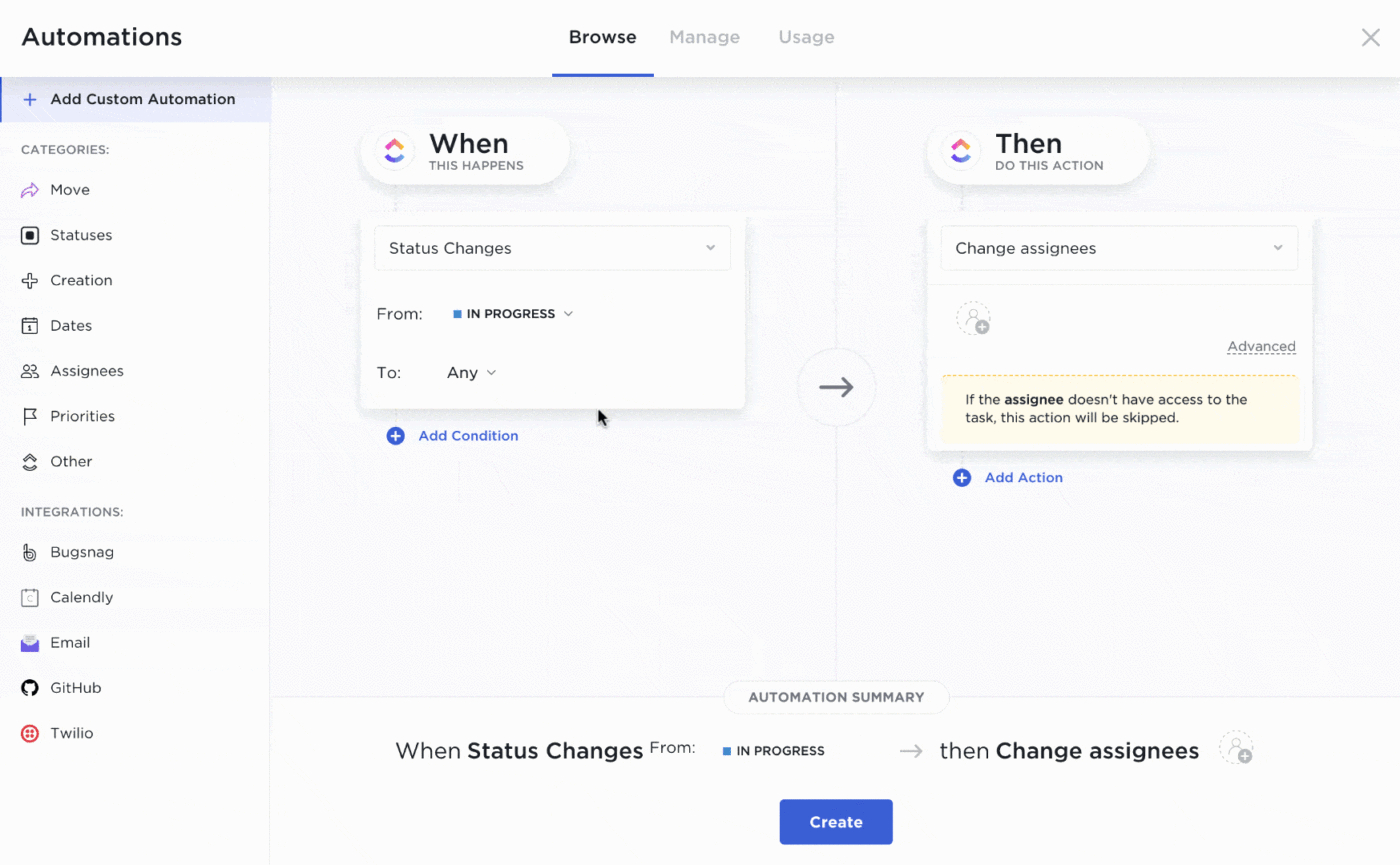
استخدم وصفات الأتمتة المُنشأة مسبقًا في ClickUp أو قم بتخصيصها بناءً على احتياجاتك، حتى يتمكن فريقك من التركيز على ما هو أكثر أهمية
إليك مثالاً على ذلك. أنت تدير خدمة توصيل وجبات سريعة صغيرة. تلاحظ أن أوقات الانتظار تزداد مع زيادة الطلب وأنك تخسر العملاء. لقد بدأ نظام إدارة الطلبات اليدوي الذي كان يعمل معك في السابق في الانهيار الآن - ورضا العملاء يتجه نحو الانخفاض.
من المحتمل أن تقترح BPI تعيين موظفين جدد أو نقل موظفين مؤقتًا من أقسام مختلفة للتعامل مع الطلبات عند الحاجة. قد تستلزم إعادة هيكلة إدارة الأعمال تنفيذ نظام إلكتروني جديد لإدارة التسليم لا يتطلب تدخلاً بشرياً كبيراً.
الحل الأول يشبه كنس الغبار تحت البساط، في حين أن الحل الثاني يمنع تراكم الغبار في المقام الأول. 🧹
إعادة هندسة العمليات التجارية مقابل إدارة العمليات التجارية إدارة العمليات هو المفهوم الأوسع من الاثنين. إنها عملية تنظيم عناصر العملية والأنشطة لضمان سير كل شيء بسلاسة. وفي حين أن إعادة هيكلة عمليات إعادة هيكلة إدارة الأعمال تحدث من حين لآخر، فإن إدارة العمليات تحدث دون توقف.
تشتمل كل من إدارة عمليات إدارة الأعمال وإعادة هيكلة إدارة الأعمال على بعض العناصر المتشابهة. فكلاهما يتطلب منك فحص عملياتك الحالية وتحديد المشاكل وإصلاحها. كما أن الهدف هو نفسه - تحسين جودة المنتج أو الخدمة.
متى تنفذ استراتيجية إعادة هيكلة إدارة الأعمال؟
من الناحية المثالية، يجب عليك تنفيذ استراتيجية إعادة هيكلة إدارة الأعمال عاجلاً وليس آجلاً. وبهذه الطريقة، سيكون من الأسهل إعداد المسرح لجميع الأعمال المستقبلية وجهود التوسع. كلما كانت شركتك أكبر، كلما كانت إعادة هندسة عملياتها أكثر تكلفة وصعوبة واستهلاكًا للوقت.
في الواقع، عادةً ما يُطرح موضوع إعادة هندسة إدارة الأعمال كموضوع عندما تكون الشركة في حالة ركود أو أداء ضعيف، مع فشل جهود إعادة هندسة عملياتها. في مثل هذه الحالات، يكون الوقت المناسب لتنفيذ استراتيجية إعادة هيكلة إدارة الأعمال هو الآن.
إذا فاتتك الفرصة المثالية، فلا تيأس. يمكنك إجراء تغييرات عميقة على عملية الأعمال في أي وقت تراه مناسبًا. سيتطلب الأمر مزيدًا من العمل والتخطيط الدقيق، ولكنه قد يؤدي إلى النجاح. وكما ذكرنا، فإن الفوائد طويلة الأجل تجعل الأمر يستحق العناء.
الخطوات الأربع لإعادة هندسة عمليات الأعمال التجارية
يختلف شكل عملية إعادة هندسة إدارة الأعمال باختلاف كل حالة على حدة. وهي تنطوي بشكل عام على أربع خطوات، والتي سنوضحها في القسم التالي.
لاحظ أن عملية إعادة هندسة إدارة الأعمال الفعالة إدارة المشروع أداة مثل انقر فوق يمكن أن يجعل عملك أسهل. إلى جانب جعل بياناتك مركزية، فإنه يوفر العديد من الميزات لفعالية تخطيط المشروع والتنفيذ. بدلاً من التنقل بين تطبيقات متعددة، يمكنك تشغيل عمليات معقدة مثل إعادة هيكلة إدارة الأعمال من منصة واحدة.
وفِّر الوقت باستخدام قالب خطة مشروع إعادة هندسة العمليات التجارية ClickUp . وهو يأتي محملاً مسبقًا بأعمدة مخصصة وأوضاع عرض، أي "طرق عرض" مصممة لمساعدتك على التعامل مع إعادة هندسة إدارة الأعمال بثقة.
كما أنه مجاني! والآن، دعنا نعود إلى خطوات عملية الأعمال الأربعة الأساسية.
الخطوة 1: الإعداد والبحث
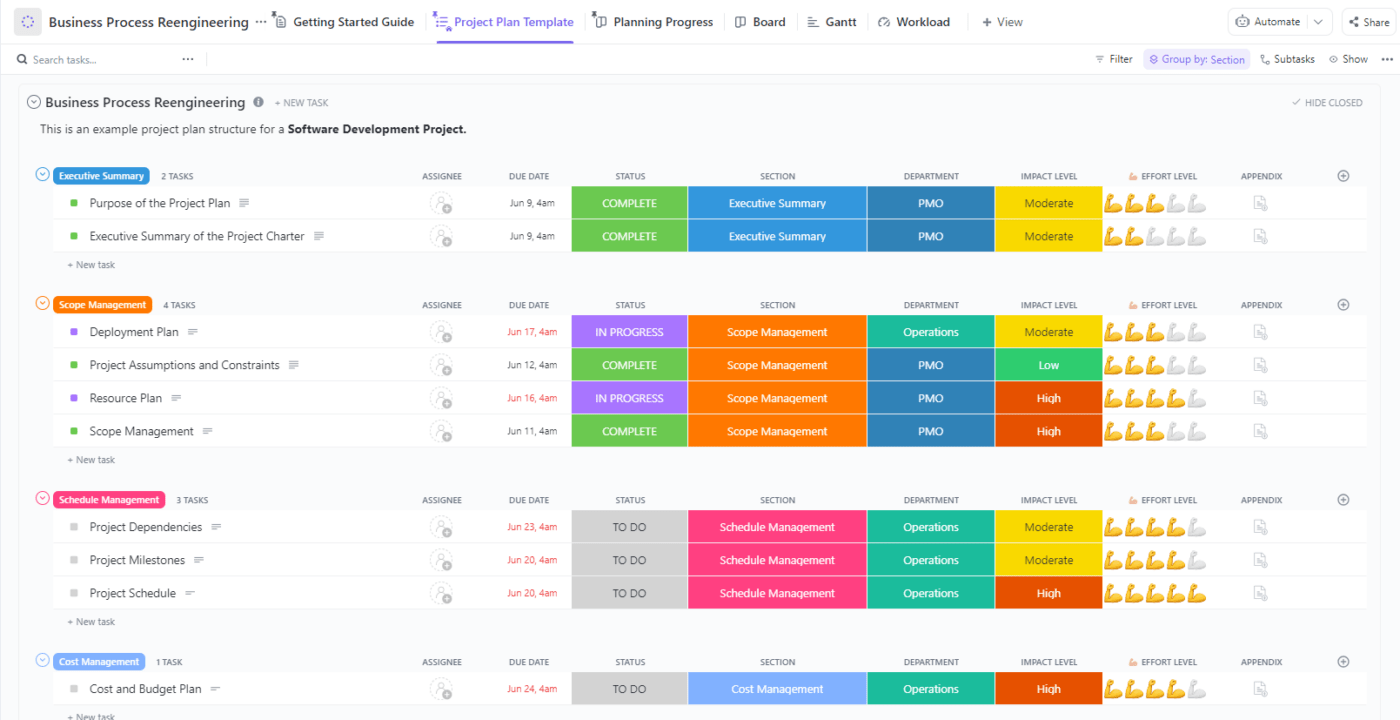
استخدم قالب قالب خطة مشروع إعادة هندسة العمليات التجارية ClickUp واجعل هذه العملية الشاقة أكثر سهولة في الإدارة
تتطلب عملية معقدة مثل إعادة هندسة إدارة الأعمال أن يكون الجميع على أهبة الاستعداد. 🤝
يجب أن تقوم بتجميع فريق عمل ماهر ومتحمس يكون مسؤولاً عن مشروع إعادة الهندسة. يجب أن يشمل فريق عمل عملية إعادة هندسة الأعمال الخاص بك:
- خبراء خارجيين على دراية جيدة في إعادة هندسة إدارة الأعمال
- مدير رفيع المستوى يتولى القيادة في الفريق أو المؤسسة
- موظف متمرس على دراية بخفايا العملية وخباياها
لمعرفة ما هو ناقص، يجب عليك التحقيق في العملية بشكل متعمق. قم بتحليل الأنشطة والمشاركين والأدوات والأساليب المستخدمة من البداية إلى النهاية. اطلب من موظفيك وعملائك إكمال استطلاعات الرأي مجهولة المصدر واستخدام ClickUp نموذج خطة مشروع إعادة هندسة العمليات التجارية للوصول إلى هناك بشكل أسرع.
ما الذي يسبب معظم المشاكل
ابحث عن الخطوات التي تسبب باستمرار التأخير والأخطاء وشكاوى العملاء. تأكد أيضًا من ملاحظة الخطوات التي أثبتت فائدتها.
يسمح لك جمع المدخلات من جهات متعددة بالحصول على الصورة الأكثر واقعية. بالتسلح بهذه المعرفة، ستجد أنه من الأسهل إعادة بناء العملية وتحديد الاختناقات.
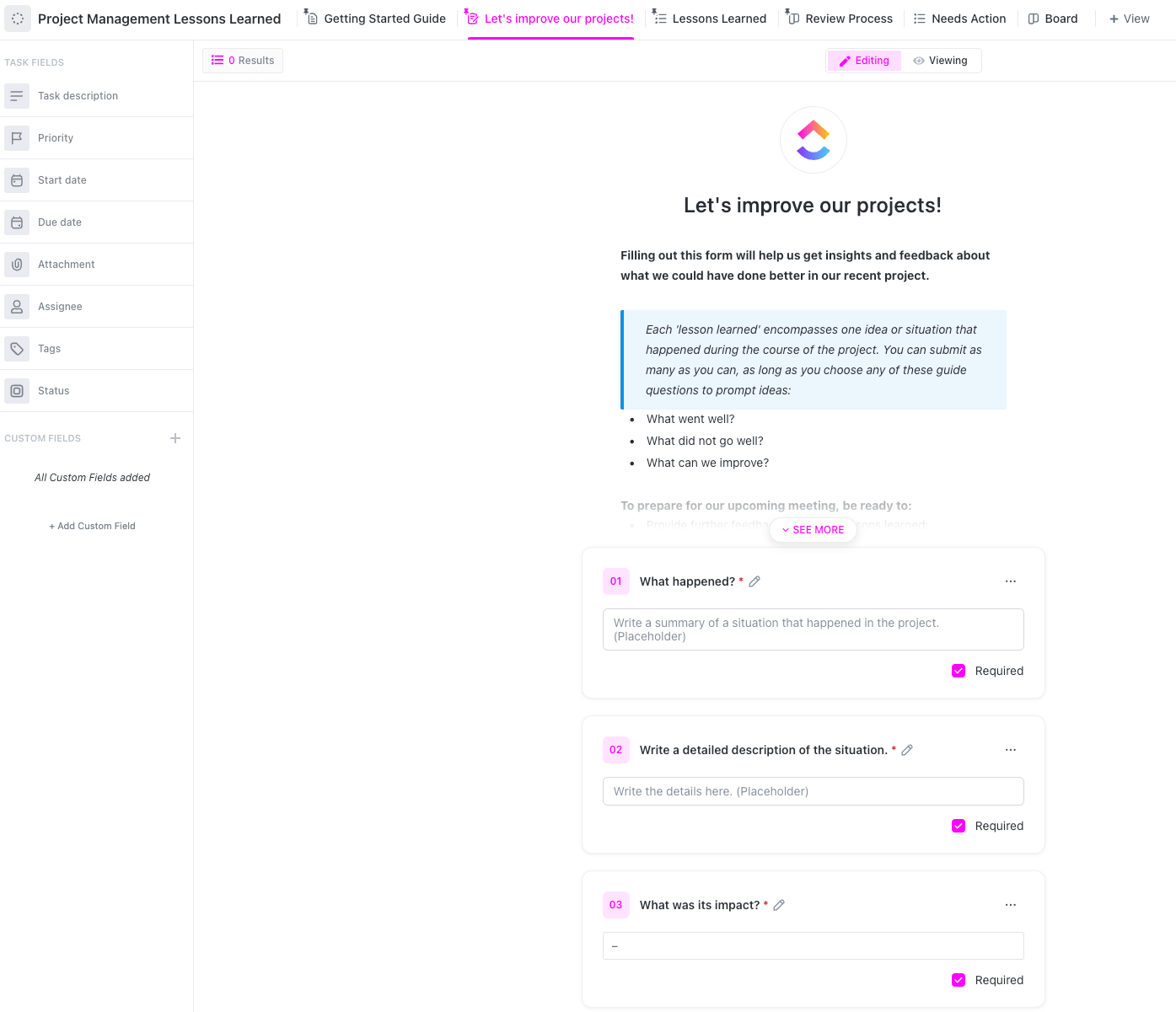
استخدم طريقة عرض النموذج لجمع الملاحظات وتحليلها وتنظيمها
جمع البيانات والتعامل معها أمر سهل للغاية مع ClickUp. استخدم نماذج ClickUp لإنشاء استطلاعات رأي فعالة، والاختيار من بين أكثر من 10 أنواع من الحقول. قم بإدارة فريقك في طريقة عرض القائمة أو اللوحة. أضف تفاصيل الاتصال بهم أو أي معلومات أخرى ذات صلة في الأعمدة.
تعيين المهام أو المهام الفرعية وإنشاء التبعيات لسير عمل أكثر كفاءة. ✔️
الخطوة 2: تخطيط العمليات
الآن بعد أن عرفت أجزاء العملية التي تعمل والتي لا تعمل، حان الوقت لإعادة تصميمها.
خطوة بخطوة، قم بصياغة سير العمل الجديد باستخدام تخطيط العملية . قد تجد أن التصور يساعدك على فهم أفضل للعمليات المعقدة وكيفية تأثير أنشطة محددة على بعضها البعض.
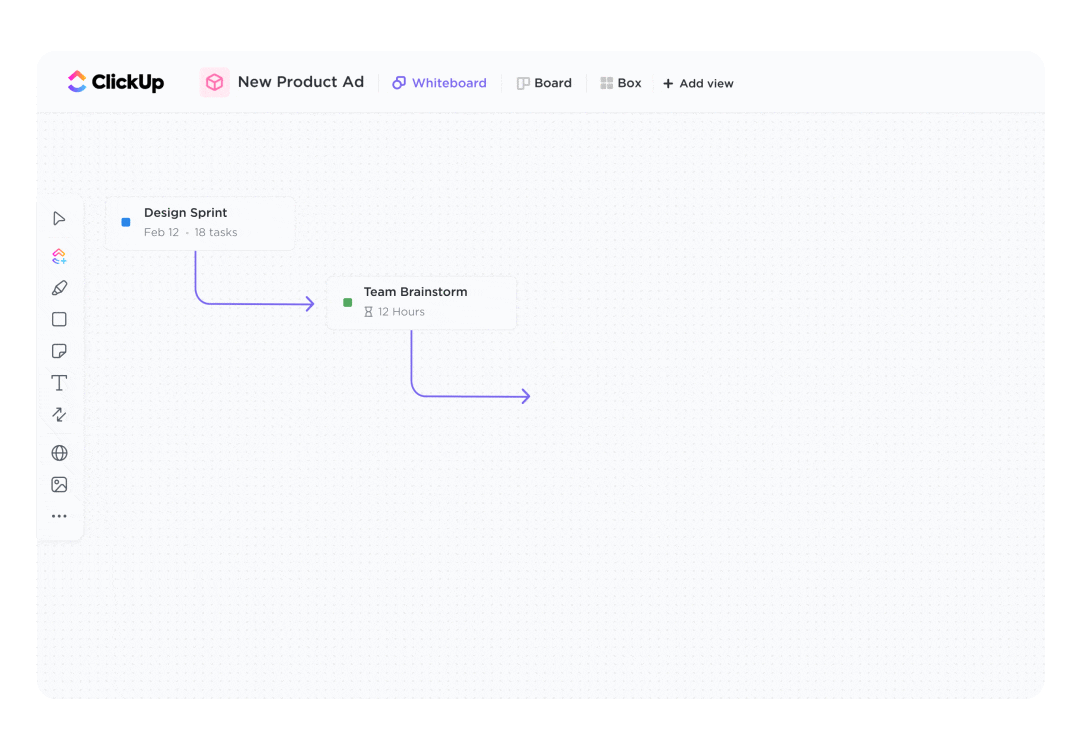
ارسم الروابط واربط العناصر معًا لإنشاء خرائط طريق أو سير عمل من أفكارك مع فريقك في ClickUp Whiteboards
مع اللوحة البيضاء لـ ClickUp يمكنك إنشاء خرائط عملية جذابة ومخططات انسيابية لتوضيح الخطوات التي تنطوي عليها استراتيجية إعادة هيكلة إدارة الأعمال.
استخدم أشكالاً مختلفة للإشارة إلى نوع النشاط. على سبيل المثال، تشير الأشكال الماسية عادةً إلى خطوات اتخاذ القرار. أضف أسهمًا لتحديد الاتجاه وتبعيات المهام. إلى جانب الأشكال والأسهم، لا تتردد في إضافة الصور أو مقاطع الفيديو أو بطاقات الموقع الإلكتروني أو المستندات أو الرسومات لتوضيح وجهة نظرك.
بمجرد تصور العملية بأكملها، حدد بداية ونهاية جهود إعادة هيكلة إدارة الأعمال الخاصة بك وأضف الخطوات البينية. يمكنك تحويل العقد إلى مهام تفاعلية، وفتح ميزات إضافية مثل قوائم المراجعة والتعليقات وتتبع الوقت.
![]()
سجل الوقت أثناء التنقل أو أدخله يدويًا باستخدام تتبع الوقت في ClickUp
يمكنك حتى تحديد الشخص أو القسم المسؤول عن ذلك من خلال إضافة مستطيلات في الخلفية لكل منها وفرز المهام على طول المحور الرأسي بناءً على من يحتاج إلى إكمالها.
تُسهِّل اللوحات البيضاء أيضًا التعاون مع فريق خبراء إعادة هيكلة إدارة الأعمال لديك. يمكنك العمل على خريطة العملية معًا في الوقت الفعلي ومشاركة الأفكار عبر الملاحظات. 💡
الخطوة 3: التخطيط وإدارة المهام
الخطوة التالية هي تحديد نطاق المشروع ، أي ضع استراتيجية تنفيذ لتفعيل خريطة العملية الخاصة بك. أولاً، حدد هدفك النهائي واشرح كيف يتوافق مع أهداف الشركة.
بعد ذلك، ضع قائمة بجميع الخطوات اللازمة لتحقيق إعادة هيكلة إدارة الأعمال. ضع في اعتبارك ما إذا كنت بحاجة إلى توظيف أشخاص جدد، أو تدريب الموظفين الحاليين، أو شراء معدات جديدة، أو ترقية المعدات الحالية.

من السهل إضافة قيم مالية إلى المهام لإبقاء ميزانيات المشاريع على المسار الصحيح
كن محددًا قدر الإمكان لتجنب سوء الفهم. لا تنسى حساب التكاليف للسماح بدقة تخصيص الميزانية .
في النهاية، حدد مقاييس النجاح. سيسمح لك القيام بذلك بمعرفة مدى تحسن سير العمل بالضبط مع عملية إعادة الهندسة.
كما قمت بالفعل بتحديد أهداف إعادة هندسة إدارة الأعمال وأوجه القصور في العملية الحالية, تحديد مؤشرات الأداء الرئيسية يجب أن يكون سهلاً. كما أنه من الجيد أيضًا أن يكون لديك خطة طوارئ في حالة عدم نجاح الخطة (أ).
يمكنك القيام بكل هذا ضمن مستندات ClickUp . من ميزات التنسيق المتقدمة إلى التحكم في الإصدار، يحتوي ClickUp على كل ما تحتاجه لإنشاء مستندات عملية وجذابة بصرياً.

يتيح مستندات ClickUp Docs التنسيق المنسق وأوامر الشرطة المائلة للعمل بكفاءة أكبر
ضع اللمسات الأخيرة على خططك من خلال إدراج جميع المهام والمهام الفرعية وتعيينها في ClickUp. أضف المرفقات وقوائم المراجعة والمعلومات المهمة لمساعدة المكلفين على إكمال مهامهم.
استخدم طريقة عرض عبء العمل لتقييم قدرة الأفراد وتوافرهم. عرض الجدول الزمني والمراحل الرئيسية وإدارتها في عرض Gantt أو الجدول الزمني. ⏱️
الخطوة 4: التنفيذ
بمجرد أن تصبح جاهزًا، ابدأ في تنفيذ خطة إعادة هندسة العمليات على نطاق صغير. قم بتوثيق وتدقيق جميع الأنشطة وتقييم التقدم المحرز بعد كل مرحلة من مراحل التنفيذ. وفي الوقت نفسه، قم بإنشاء ضوابط قوية للمشروع لضمان الالتزام بالتكلفة والجدول الزمني.
إذا لم تُظهر مؤشرات الأداء الرئيسية التي اخترتها تحسناً ملحوظاً مقارنةً بخط الأساس، فارجع إلى مرحلة التخطيط وأعد التقييم، ثم حاول مرة أخرى. إذا كانت النتائج في صالح العملية الجديدة، قم بتطبيقها تدريجيًا على نطاق أوسع.
بعد ذلك، قم بقياس وجمع الملاحظات من أصحاب المصلحة.
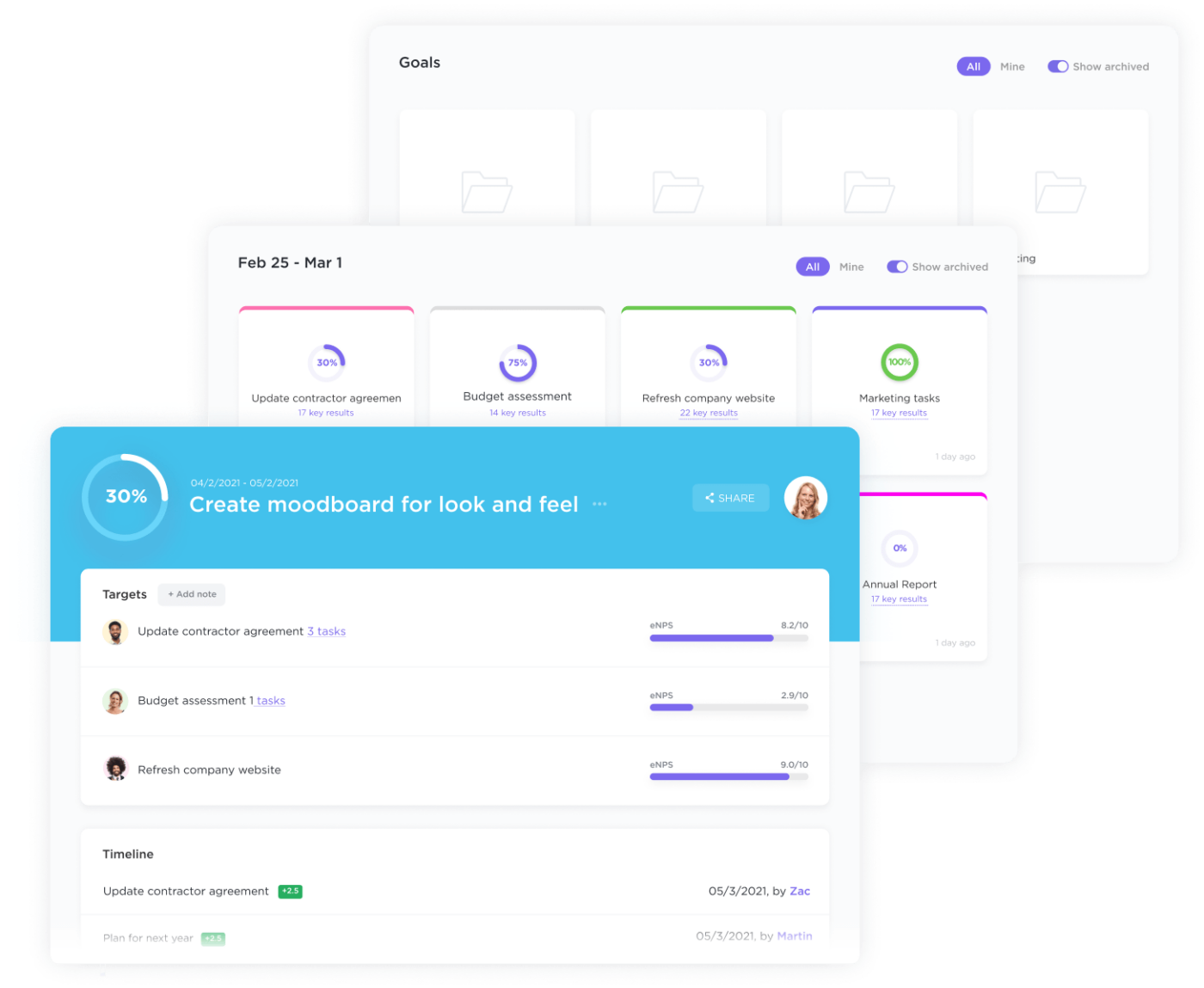
ابقَ على المسار الصحيح لتحقيق أهدافك من خلال جداول زمنية واضحة وأهداف قابلة للقياس وتتبع التقدم التلقائي
في ClickUp، يمكنك تعيين أهداف قابلة للتتبع وقياس التقدم المحرز تلقائيًا أثناء تقدمك. توفر المنصة العديد من فرص الأتمتة الأخرى، المدمجة والمخصصة.
يمكنك التعاون مع فريقك في ClickUp في كل خطوة من خطوات عملية إعادة الهندسة. ناقش الأمور في تعليقات المهام أو عرض الدردشة . تحرير المستندات والملفات الأخرى، وعرض التغييرات في الوقت الفعلي، وتلقي إشعارات بها.
يمكن لموظفيك أيضًا تتبع الوقت داخل التطبيق، مما يجعل إجراءات التعويض أسهل. 💸
أمثلة على إعادة هندسة العمليات التجارية
إحدى أكثر الطرق فعالية للتعلم هي القدوة، لذا دعنا نستكشف قصتي نجاح مشهورتين في إعادة هندسة عمليات الأعمال !
T-Mobile: الاتصالات السلكية واللاسلكية
المشكلة: حتى عام 2015 تي موبايل يتألف دعم العملاء عبر الهاتف من وكلاء الاستجابة الأولى وأقسام متعددة متخصصة في أنواع مختلفة من المشاكل. وبسبب ذلك، كان استكشاف الأخطاء وإصلاحها يستلزم عادةً تحويلات متعددة للمكالمات. استغرقت العملية الكثير من الوقت وأدت إلى إحباط العملاء.
الحل: بعد تحليل العملية، أدركت شركة T-mobile أن الحل الأكثر كفاءة هو تدريب وكلاء دعم العملاء على التعامل مع جميع المكالمات من البداية إلى النهاية. قامت الشركة بتجميع فرق متعددة الوظائف من الخبراء لإجراء تدريب المندوبين. كما غيرت شركة T-mobile أيضًا ممارسات تقييم الوكلاء، وتحولت إلى نموذج قائم على الأداء الفردي والجماعي.
النتيجة: انخفض عدد المكالمات لكل حساب بنسبة 21%، وانخفضت تكاليف المكالمة الواحدة. ووصل معدل الاحتفاظ بالعملاء إلى أعلى مستوياته على الإطلاق. انخفض معدل دوران الموظفين. حققت T-mobile نجاحاً لم يسبق له مثيل.
هانيويل: التكنولوجيا والهندسة
المشكلة: في التسعينيات هانيويل تهدف إلى تقليل عدد العيوب في عملية البناء في إحدى وحدات أريزونا التابعة لها. وكشف التحقيق عن أن المشكلتين الرئيسيتين كانتا الحاجة إلى مزيد من التعاون بين فرق العمل وعدم وجود سلطة على القرارات التي تؤثر على عملهم.
الحل: أوقفت هانيويل جميع العمليات وأنشأت نظام إنتاج متكامل جديد مع نظام كامل لمراقبة الجودة. خضع الموظفون للتدريب. وتم تجميع فرق متعددة المهارات وتكليفها بالتعامل مع إنتاج المنتجات من البداية إلى النهاية. وعلى غرار شركة T-Mobile، أدخلت الشركة نموذج تقييم قائم على الجودة والأداء.
النتيجة: استغرقت العملية ثلاث سنوات، لكن النتائج تتحدث عن نفسها. فقد شهدت هانيويل انخفاضًا بنسبة 70% في العيوب، وانخفاضًا بنسبة 72% في زمن دورة الإنتاج على الأجزاء، والعديد من الفوائد الأخرى المصاحبة.
التحديات الشائعة لإعادة هندسة العمليات التجارية + الحلول
عادةً ما تكون عملية إعادة هندسة العمليات التجارية عملية طويلة ومعقدة، لذلك يمكن أن تنطوي على العديد من المشاكل. سنتناول بعضها أدناه:
نقص الدعم
عندما يشرع المدير في التغيير، غالبًا ما يقابل بمقاومة من القيادات العليا. قد يكون إقناعهم بتبني الفكرة أمرًا صعبًا، حتى لو كان صاحب الاقتراح خبيرًا في العملية المعنية.
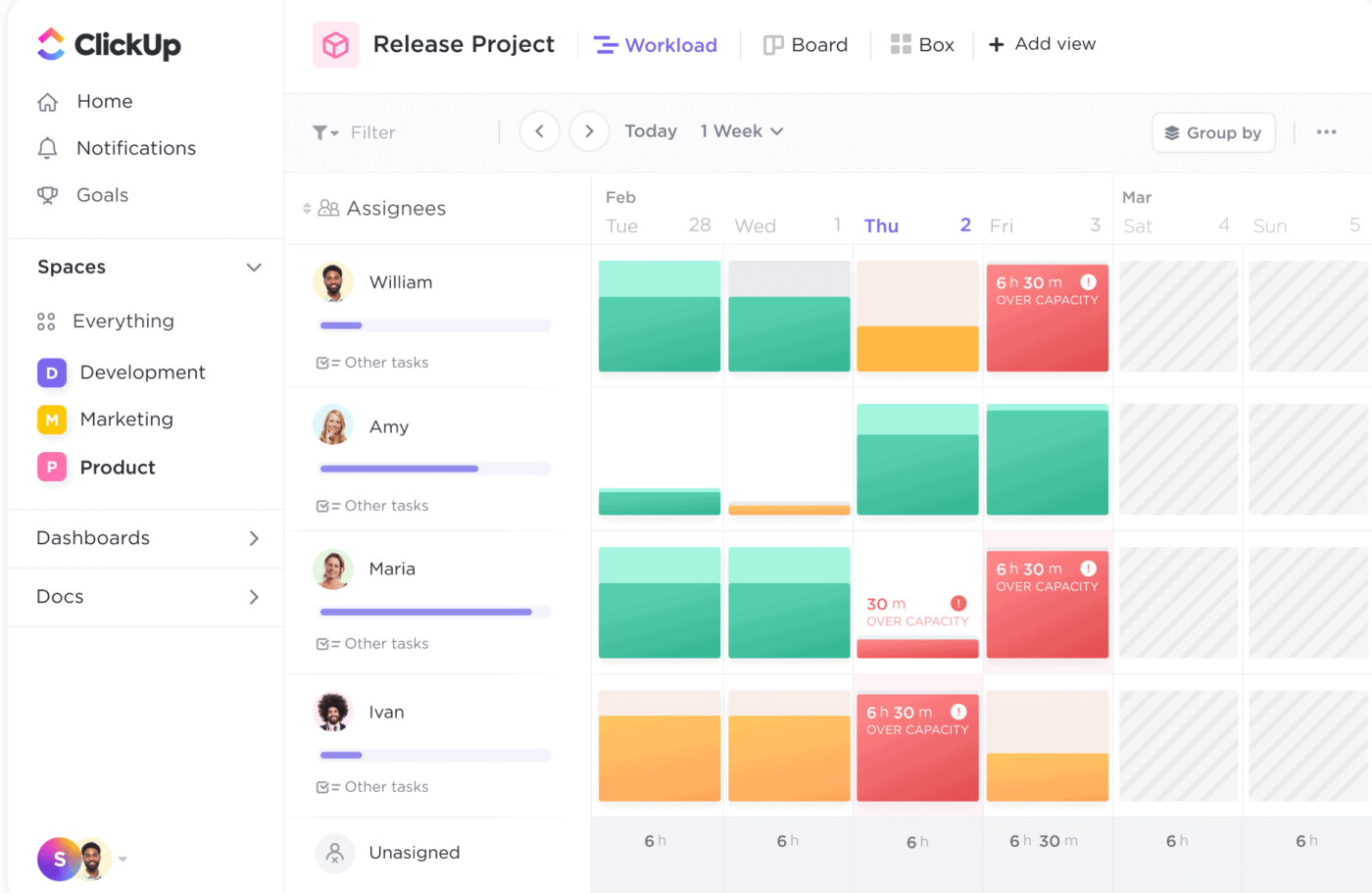
افهم في لمحة سريعة من في فريقك الذي يعاني من نقص أو إفراط في العمل حتى تتمكن من إعادة تخصيص مواردك بسهولة
كما أن الحصول على الدعم من الرؤساء والمالكين شيء، ولكن إقناع الموظفين في الخنادق بتنفيذها شيء آخر. 🐟
حتى لو لم تكن الأموال مشكلة، فإن تغيير النموذج الحالي والمألوف قد يكون كذلك.
الحلول المحتملة:
- اجمع أكبر قدر ممكن من الأدلة لإثبات أن شركتك ستستفيد من إعادة هيكلة إدارة الأعمال
- تقديم حوافز للمشاركة
- التحلي بالصبر والمثابرة
- تنفيذ التغييرات بشكل تدريجي لجعل عملية الانتقال أكثر سلاسة
الإعداد غير الكافي
يمكن أن تحدث أخطاء كثيرة في مرحلة الإعداد.
على سبيل المثال، إذا كان فريق الخبراء متحيزًا، فقد يدفعون بأجندة ليست بالضرورة الأفضل للشركة. قد يؤدي وجود عدد كبير جدًا من الأشخاص في الفريق إلى حدوث ارتباك، في حين أن عدم وجود عدد كافٍ من أعضاء الفريق قد لا يستطيعون مواكبة ذلك. كما أن نقص المعرفة أو الحافز يمكن أن يكون مشكلة أيضاً.
ومن العوائق الشائعة الأخرى التحليل غير السليم للأسباب. فبدون فهم السبب الحقيقي لأوجه القصور في عملية ما، قد يكون محكومًا عليك بتكرارها.
الحلول المحتملة:
- لا تتسرع في عملية الإعداد
- قم بتجميع فريق متعدد المهارات من المحترفين
- جمع الملاحظات من وجهات نظر متعددة وتشجيع الشفافية
قيود الموارد
من المحتمل أن يكون نقص الموارد هو المشكلة الأكثر شيوعًا في إعادة هيكلة إدارة الأعمال ويمكن أن يعيق تقدمها بشدة. وسواء كان ذلك الوقت أو المال أو القوى العاملة، يجب قطع بعض الزوايا لتحقيق التغيير.
ولا يكون ذلك ممكنًا إلا إذا كان الجميع على متن الطائرة وتم إجراء الاستعدادات في وقت مبكر.
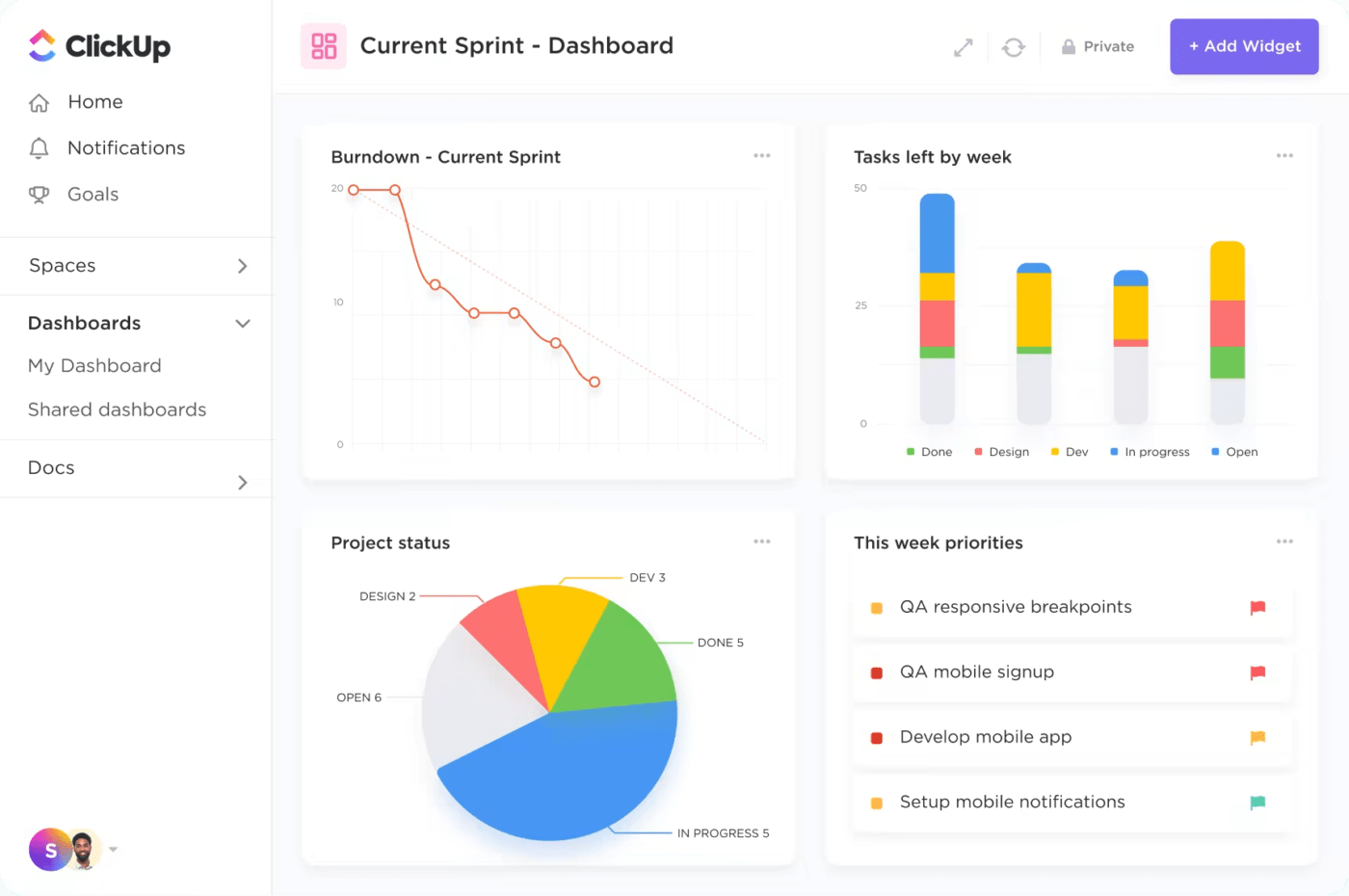
تتبع ومراقبة المهام والموارد وتقدم المشروع في عرض لوحة معلومات ClickUp Dashboard
الحلول المحتملة:
- كن واضحًا بشأن مقدار الوقت والجهد اللازمين لإعادة هيكلة إدارة الأعمال
- التركيز على الفوائد التي يجب أن تحققها العملية الجديدة
- ابدأ التخطيط في الوقت المحدد
- تحسين مؤسستك وإدارة الوقت المهارات
التنفيذ غير المنتظم
إذن، لقد وصلت إلى مرحلة التنفيذ. مرحى! 🎉
لم تتضح الأمور بعد. ما زلت بحاجة إلى تنفيذ العملية الجديدة بطريقة تلتزم بها. إذا قمت بتطبيقها بشكل غير كافٍ وغير متناسق، فلن تنجح.
هناك نقطة أخرى يجب ملاحظتها وهي أن إعادة هيكلة إدارة الأعمال ليست حدثًا لمرة واحدة. إنها عملية تحسين متعمقة مستمرة. إذا لم تقم بقياس مدى فعالية استراتيجية إعادة هندسة إدارة الأعمال الخاصة بك، فمن الذي سيقول إنها أفضل من الاستراتيجية السابقة؟
قد تُظهر مؤشرات الأداء الرئيسية أن بعض أجزاء النهج الجديد دون المستوى الأمثل ويجب إعادة تقييمها.
الحلول المحتملة:
- تقبل أن العمل لم ينتهِ بمجرد تنفيذ العملية الجديدة
- البدء بشكل صغير وتنفيذ التغييرات شيئًا فشيئًا
- الاختبار والقياس طوال الوقت
- الإشراف على التكيف وتوفير دعم إضافي عند الحاجة
كسر القالب والوصول إلى مستويات جديدة من الكفاءة مع إعادة هيكلة إدارة الأعمال
من خلال إعادة تصميم تدفقات العمل بشكل أساسي، يمكنك تبسيط العمليات وتقليل التكاليف ودفع عجلة النمو. على الرغم من الصعوبات، فإن الفوائد المحتملة طويلة الأجل لإعادة تصميم عمليات إعادة تصميم الأعمال تجعلها مسعىً جديرًا بالاهتمام لأي شركة تتطلع إلى البقاء في المقدمة في مشهد الأعمال الديناميكي.
الخروج من القديم، والدخول في الجديد! امنح مؤسستك نفسًا جديدًا من خلال تبني إعادة هندسة عمليات الأعمال. 🛫

